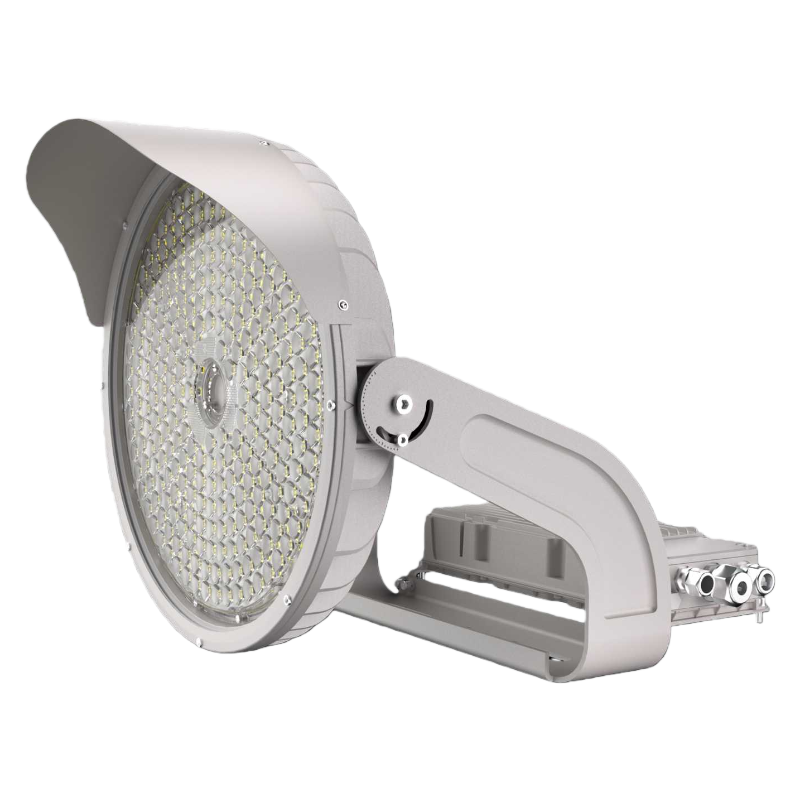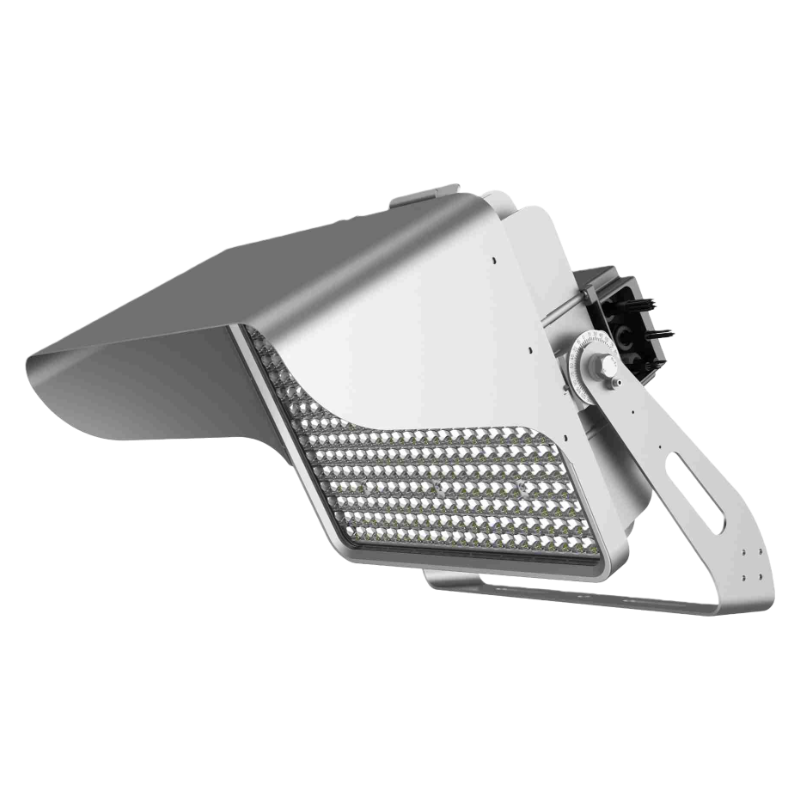What is Warehouse Lighting?
LED warehouse lights are designed for large, open buildings that require bright lighting, such as auditoriums, gymnasiums, manufacturing plants, sports centers, and distribution centers, but can also be used in smaller applications such as garages, columnar warehouses, and shops. They can illuminate work areas, increase productivity, reduce maintenance, and save significant energy. It's time to use LED lights in your warehouse.
Warehouses are the backbone of many businesses, serving as storage and distribution centers for a wide variety of products. However, ensuring there is proper lighting within these facilities is often overlooked, leading to safety hazards, lost productivity, and unnecessary energy costs.In this article, we’ll look at some top tips for improving warehouse lighting to increase efficiency and save costs.
LED Lighting Conversion
Switching to LED fixtures is one of the most effective changes you can make to your warehouse lighting. LED lights offer several advantages over traditional lighting technologies. They are extremely energy efficient, consuming less electricity while providing the same or even better lighting. LED lights also last longer, which means fewer replacements and lower maintenance costs. By making this simple switch, you can immediately see savings on your energy bills.
Lumens are more effective as a lighting planning tool than watts. People are beginning to realize that lumens are more useful in determining the amount of light needed in an area.
- For a 400-watt metal halide, check out our 150-watt model. You'll want 14,000 to 20,000 lumens. If you need more light, go up to 240, or down to 100 if a little less is okay.
- For a 250-watt metal halide, look for 11,000 to 14,000 lumens. 80 or 100 watts are good.
- lTo replace a T5 or T8 fixture, consider 9,000 to 17,000 lumens. These lamps come in standard and high output (HO) with 2 to 8 lamps per fixture. Each standard fixture has about 60 effective lumens per watt, while the HO has about 80 effective lumens per watt.
Lighting Layout and Design
Proper lighting layout and design are critical to creating a safe and efficient warehouse environment. First, strategically plan the placement of lighting fixtures to ensure even illumination throughout the space. Consider combining overhead, task, and ambient lights to minimize shadows and create a well-lit atmosphere. Proper lighting design can improve visibility, reduce accidents, and make it easier for employees to complete tasks efficiently.
Start by measuring the space and height where the lights will be located. Knowing the dimensions will help you plan. Step Two: Check existing light locations if any. If the spacing is correct, using the same locations to install the LED warehouse lights can help reduce installation costs. Next is laying out the grid. The taller the lights, the brighter they will be and the farther apart they will be. Here are some examples; at a 15-foot height, you would need about 20,000 lumens and an average 14 foot spacing. At a 25-foot height, you would need about 30,000 lumens and 20 foot spacing. These are suggestions, some areas with light motion will require more light. Ask an expert to plan or do a computer photo study.
Warehouse Foot Candle
The Illuminating Engineering Society (IES) has recommendations for warehouse lighting. This will depend on several factors, namely the type and size of the facility. Here are some foot-candle (fc) recommendations for warehouses, workshops, and manufacturing facilities;
|
Storage Warehouse Lighting |
Footcandles |
|
Inactive Warehouses |
5-10 fc |
|
General Warehouse Aisles |
10-30 fc |
|
Active Warehouse (Large Items) |
20 fc |
|
Active Warehouse (Medium Items) |
20 fc |
|
Active Warehouse (Small Items) |
30-60 fc |
|
Active Warehouse (Fine Items) |
30-60 fc |
|
Cold Storage / Refrigeration |
10-30 fc |
|
Warehouse Dock Lighting |
5-20 fc |
|
Receiving and Staging Area |
15-60 fc |
(table 1 )
|
Manufacturing Warehouse Lighting |
Footcandles |
|
Packaging and Labeling |
30 fc |
|
Coarse Material Processing |
10 fc |
|
Medium Material Processing |
30 fc |
|
Fine Material Processing |
50-100 fc |
|
Simple Assembly |
30 fc |
|
Medium Assembly |
25-100 fc |
|
Difficult Assembly |
100-200 fc |
|
Complicated Assembly |
50-200 fc |
|
Exacting Assembly and Inspection |
150-600 fc |
|
Grain Processing |
70 fc |
|
Food Processing |
70 fc |
|
Workshop & Maintenance |
50 fc |
(table 2 )
|
Warehouse Parking Lot Lighting |
Footcandles |
|
Horizontal illuminance |
0.2 fc (minimum) |
|
Vertical Illuminance |
0.1 fc (minimum) |
|
Uniformity Ratio |
20:1 (maximum) |
|
General Parking Lots |
2-5 fc |
|
Parking Structures |
2-5 fc |
|
Underground Parking Garages |
1 fc |
(table 3)
Color Temperature
Light color is expressed in Kelvin, also known as CCT (color temperature), light is measured in temperature or Kelvin. Kelvin is a technical measure of whether the light color is warm or cool.
3000K – Too warm for a warehouse, but may be fine if the high bay is used in a restaurant or church.
4000K – Natural, suitable for business or other work areas. It is ideal for offices, or for those who find 5000K too harsh.
5000K – Pure white, suitable for large spaces and outdoors. The most popular high bay light, accounting for about 85% of sales. 5000K is a popular choice for spaces like auditoriums, ballrooms, and huge spaces. We highly recommend using 5000K lights for large spaces, especially outdoors where a lot of lighting may be needed. It can effectively cover the entire area.
5700K - We do not recommend going above 5000K, and the AMA has warned against using 5700K and 6500K. That's what the American Medical Association says, and it's bad for your health. We just trust them here.
Color Rendering Index (CRI)
The quality of light from LED lighting is significantly better than traditional lighting. LED lighting has a very high CRI (color rendering index), which means that the light it produces is more accurate and true to life. The CRI ranges from 0-100, with 100 representing natural sunlight. LED lighting typically has a CRI of 90, and sometimes even higher - whereas traditional lighting rarely has a CRI above 80. This is actually a fairly noticeable difference, and can be clearly noticed with the naked eye when compared side by side.
In addition to the higher CRI, the amount of usable light from LED lighting is also increased by about 40% over traditional lighting. This is due to the way the light is focused. Traditional lighting typically emits light in a 360° pattern, requiring the use of reflectors to redirect the light in the correct direction.
This results in a significant loss in efficiency, which is not the case with LED lighting. Since LEDs can only produce a 180° pattern, they do not require reflectors to redirect the light, as all the light is facing the correct direction to begin with. The increase in available light, combined with the ultra-high CRI of LED lighting, can improve warehouse worker safety by more accurately illuminating their workspace and reducing their eyestrain.
Warehouse Lighting Recommendations for Different Locations
Utility and Storage Rooms - Since these areas do not require strong light output, energy conservation, and minimal maintenance, lighter lights can be used. Linear utility lighting, as well as replacement bulbs such as T8 LED tubes and corn lights are most commonly used.
Warehouse Loading Dock Lighting - As a high-traffic area, warehouse loading docks require adequate lighting to ensure safe and efficient work. High bay luminaires are most commonly used indoors at the dock, which produce excellent lumen output. Outdoors, ceiling lights, wall lights, and floodlights are the best choices for weatherproof lighting.
Overhead Crane Safety - There are several luminaires designed specifically for overhead cranes and machinery. The main ones include linear crane lights and spotlight crane lights. These lights create an isolated safety zone below the load carried by the crane head, alerting workers to the danger above.
Forklift Safety - As part of heavy mobile machinery, forklifts can cause serious injuries or even death if they are not properly understood in terms of safety. Since most forklift accidents occur due to a lack of situational awareness, forklift safety strobe lights are one of the most effective ways to reduce accidents. These lights use an external driver to power a bright LED light that clearly indicates the location of the forklift.
Shop Floors - Due to the meticulous nature of work in the average shop floor, quality lighting is very important. For this application, the most common type of fixture is typically a low bay fixture due to their excellent lumen output over a large area. Linear shop lighting is often used to fill in any gaps that may be left by high powered low bay lighting.
Cold Storage - Since these lights are exposed to condensation during cold storage, they must be sealed to prevent moisture. Moisture resistant fixtures are the best choice for this application as they are not affected by moisture and provide a steady lumen output over a large area.
Warehouse Exteriors - For building exteriors, the best solution to ensure adequate lighting is wall sconces. These lights are sealed from the elements, have a long lifespan and require little maintenance.
Warehouse Parking Lots - Parking lots are large areas that require lighting to ensure the safety of users. For this application, floodlights are the preferred choice as they provide high intensity lighting in a relatively compact package and are easily mounted on poles or other exterior mounting surfaces.
What is the purpose of industrial warehouse lighting?
The main reason for using lights is to illuminate areas where you wish to create visibility. Creating a well-lit space allows warehouse workers to see more clearly, enabling them to work more effectively and efficiently during the work hours, especially at night when the surrounding environment is very dark.
A properly planned industrial warehouse lighting scheme allows you to create different zones with different brightness levels within the workplace and allows workers to customize their work environment by selecting the tasks that need to be performed at a given time.
Choosing the right commercial interior lighting fixtures can also promote safety and help prevent accidents, thereby increasing productivity and reducing costs. The right industrial warehouse lighting is an excellent investment as it benefits both the company and its employees.
- Retail and sports venues need more light—80-100-foot candles at ground level. For retail, at least 80-100 foot candles at ground level creates a high-end shopping experience. Gyms and sports venues need the same level of light.
- Manufacturing height should be about 60-80 foot candles at ground level.
- Warehouses are closer to 40 to 60-foot candles at ground level.
- Storage height can be up to 30-foot candles at ground level.
Conclusion
LED warehouse lights are a good choice for those who want to improve the lighting quality and efficiency of large indoor spaces. LED warehouse lights offer many advantages over traditional lighting sources, such as cost savings, energy savings, appearance, simplicity, safety, and low maintenance. However, to choose the LED warehouse light that best suits your needs, you need to consider some parameters, such as lumens, color temperature, housing color, lens type, motion sensor, battery backup, projection, and adjustability. You can also use some accessories, such as dimmers, sensors, or timers, to control the light output, depending on your needs and preferences.












